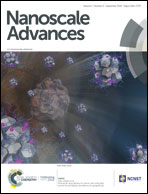Enhanced thermoelectric properties of lightly Nb doped SrTiO3 thin films†
Abstract
Novel thermoelectric materials developed for operation at room temperature must have similar or better performance along with being as ecofriendly as those commercially used, e.g., Bi2Te3, in terms of their toxicity and cost. In this work, we present an in-depth study of the thermoelectric properties of epitaxial Nb-doped strontium titanate (SrTi1−xNbxO3) thin films as a function of (i) doping concentration, (ii) film thickness and (iii) substrate type. The excellent crystal quality was confirmed by high resolution transmission electron microscopy and X-ray diffraction analysis. The thermoelectric properties were measured by the three-omega method (thermal conductivity) and van der Pauw method (electrical resistivity), complemented by Seebeck coefficient measurements. A maximum power factor of 8.9 × 10−3 W m−1 K−2 and a thermoelectric figure of merit of 0.49 were measured at room temperature in 50 nm-thick films grown on lanthanum strontium aluminate. The mechanisms behind this high figure of merit are discussed in terms of a possible two-dimensional electron gas, increase of the effective mass of the electrons, electron filtering and change in strain due to different substrates. The overall enhancement of the thermoelectric properties suggests that SrTi1−xNbxO3 is a very promising n-type candidate for room- to high-temperature applications.



 Please wait while we load your content...
Please wait while we load your content...